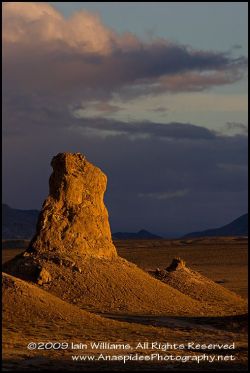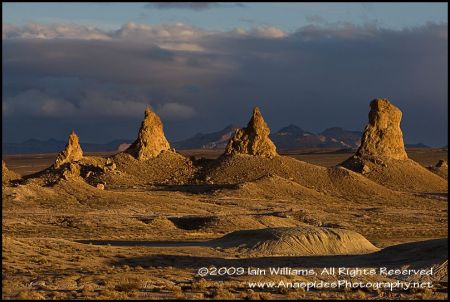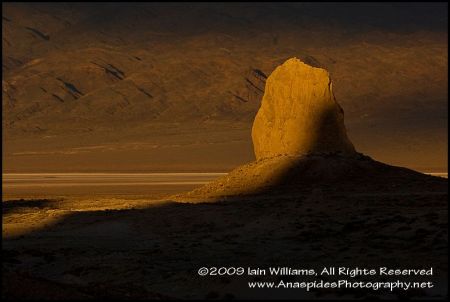Trona Pinnacles, California
 Thursday, February 12, 2009 at 6:35PM
Thursday, February 12, 2009 at 6:35PM 
Making our way south east from Death Valley, a quick stop was made at a small ghost town 6 miles from the highway. Luckily it wasn't too far off our route as the ghost town was a fizzer and did not warrant a stop.
Further south we passed a small uninspiring town who name eludes me. It seems the only thing it had going for it wads a huge chimney spewing out sulphur dioxide, the waste product from the smelting of some type of ore. The only modern aspect of this town was the fire department which sported new shining red trucks. The area was obviously poor and not wanting to embarrass any of the town occupants we made our way out of town.
Trona Pinnacles (roughly 4 hours drive from Dealth Valley) is one of the most unusual geological features in the California Desert Conservation Area. The unusual landscape consists of more than 500 tufa spires (porous rock formed as a deposit from springs of streams), some as high as 140 feet (43 m), rising from the bed of the Searles Lake.
The pinnacles vary in size and shape from short and squat to tall and thin, and are composed primarily of calcium carbonate (tufa). They now sit isolated and slowly crumbling away near the south end of the valley, surrounded by many square miles of flat, dried mud and with stark mountain ranges at either side. The spires formed underwater between 10,000 to  100,000 years ago during three ice ages.
100,000 years ago during three ice ages.
The low afternoon light at the pinnacles was quite spectacular when the sun poked through the cloud layer. After scoping the area and taking a few Polaroid shots to determine angles, I figured the best shot was to try and capture a line of pinnacles with a pano, rather individual peaks.
I set up the 70-200/2.8 and 300/2.8 on tripods and waited for the cloud to part allowing the peaks to be illuminated in light. I waited and waited and nothing happened! The light was  diffused and soft causing the landscape to appear flat, uninviting and uninteresting. I was about to “can” the shoot when the sun finally decided to make an appearance. The light was amazing. The peaks stood out from the surrounding flat environment as the last rays of light illuminated them.
diffused and soft causing the landscape to appear flat, uninviting and uninteresting. I was about to “can” the shoot when the sun finally decided to make an appearance. The light was amazing. The peaks stood out from the surrounding flat environment as the last rays of light illuminated them.
After three pano shots I quickly dismounted the camera and attempted to captures a few of the peaks. As with many low light shoots, it was a race against time attempting to capture as many images as possible in the small time envelope.
I was satisfied with the result, and due to the weather changing (storm clouds approaching) decided to head further south past Edwards Airfiorce Base catching some sleep in a local Motel 6 (not the best accommodation on the planet, but 100% better than a wet sandy tent!
The Pinnacles are recognizable in more than a dozen hit movies. Over thirty film projects a year are shot among the tufa pinnacles, including backdrops for car commercials and sci-fi movies and television series such as Battlestar Galactica, Planet of the Apes, Star Gate and Star Trek V.
THis area is not visited very often because of its relative remoteness. Altohugh you wouldn't spend a week here, it is well worth a visit - especially in morning or afternoon low light.
 California,
California,  Clouds,
Clouds,  Erosion,
Erosion,  Storm,
Storm,  Sunset,
Sunset,  Trona Pinnacles,
Trona Pinnacles,  Tufa in
Tufa in  United States of America
United States of America 

